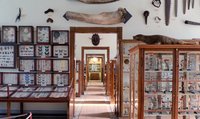Dieser Steckkamm ist Teil der Linck-Sammlung und wurde in der 2. Hälfte des 18. Jh. auf den Tonga- /Freundschaftsinseln gefertigt.
Am 13. Juli 1772 setzte das berühmte Schiff von Kapitän James Cook, die „Resolution“, ihre Segel zur zweiten Südseereise. Die Vermessung des Pazifiks führte über Kapstadt und Neuseeland, Tahiti und Polynesien, Tonga und die Oster-Inseln. An Bord befand sich der junge Forscher Georg Forster. Er dokumentierte die Weltumsegelung mit zahlreichen Zeichnungen und Objekten. Am 13. Mai 1784 besuchte er das Lincksche Kabinett in Leipzig, trug sich in das Gästebuch ein und hinterließ diesen Steckkamm von den Tonga-Inseln. Die Kämme dienten den Inselbewohnern als schmückendes Accessoire.
Belegt als handschriftliche Annotation im privaten Exemplar des Linck-Index aus der Linck-Apotheke. Dieses originale, annotierte Exemplar wird aufbewahrt in der Universitätsbibliothek Albertina in Leipzig.
en

